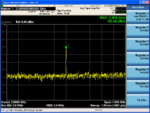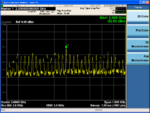@YY
Member level 2
Hi, I have design an RF amplifier circuit for my assignment. As per attached are the measured result. The first results was a -30 dBm power is feed but the RF amp wasnt powered up. The second results shows a -30 dBm power is feed and RF amp was powered up. Obviously, I think my designed was wrong since I cant see any gain. But would like to know what is the definition for the harmonics effect when the RF amp was powered up? can anyone give your valuable suggestion and explanation? Thank you.



